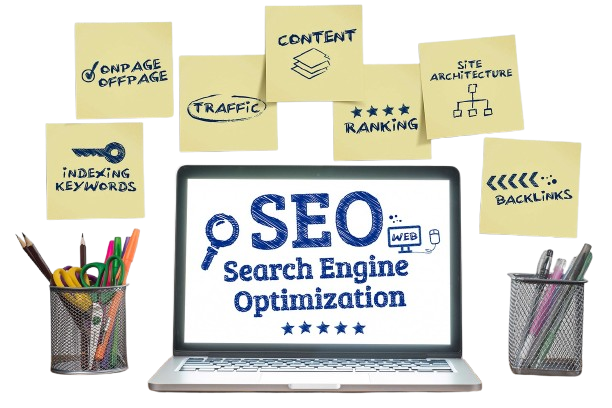A Comprehensive Guide to Search Engine Optimization (SEO)
Search Engine Optimization (SEO) is one of the most vital elements of digital marketing. It’s the process of improving your website or online content so that it ranks higher on search engines like Google, Bing, and Yahoo, helping you gain more visibility and attract organic (non-paid) traffic.
In this blog, we’ll explore what SEO is, why it’s important, and how you can implement effective SEO strategies to boost your website’s ranking and visibility
What is Search Engine Optimization (SEO)?
Search engine optimization helps to improve the website looking through its visibility and attract more organic traffic. SEO involves a combination of technical, on-page, and off-page strategies aimed at improving a website’s position on search engine results pages (SERPs). The goal is to ensure that search engines can understand your website’s content, find it relevant for users’ queries, and rank it accordingly.
There are several key components to SEO:
- On-page SEO: Optimizing individual pages on your website to rank higher.
- Off-page SEO: Building links and promoting your website through external sources.
- Technical SEO: Ensuring that your website is technically sound, fast, and mobile-friendly.
- Content SEO: Creating high-quality, relevant content that addresses your audience’s needs.

Why is SEO Important?
In today’s digital world, SEO is crucial for businesses and individuals who want to be found online. Here are some reasons why SEO is essential:
Increased Visibility and Traffic: SEO helps your website rank higher on search engines, making it more visible to potential visitors. This increased visibility translates to more organic traffic, which means more opportunities for conversions.
Better User Experience: SEO involves optimizing your website for both search engines and users, improving loading speed, mobile usability, and overall user experience. Websites that load faster and are easy to navigate tend to have lower bounce rates and higher engagement.
Cost-Effective Marketing: Unlike paid advertising, SEO is a long-term strategy that, when executed well, delivers organic traffic without ongoing costs. Once you achieve high rankings, you can continue to benefit from them without paying for every click.
Competitive Advantage: Businesses that invest in SEO can outperform competitors who neglect it. Having a strong SEO presence helps you stay ahead in competitive markets, capturing traffic and customers before your competitors do.
SEO Strategies to Improve Your Ranking
SEO is not a one-size-fits-all strategy; it requires a combination of techniques tailored to your website and audience. Let’s break down some of the most effective SEO strategies.
1. Keyword Research
The foundation of SEO is identifying the right keywords to target. These are the search terms that users are typing into search engines. Tools like Google Keyword Planner, SEMrush, Ahrefs, and Ubersuggest can help you find keywords with high search volume and low competition.
When choosing keywords, consider the following:
- Search Volume: How often a keyword is searched.
- Keyword Difficulty: How competitive the keyword is.
- Search Intent: What the user is looking for when they use a particular keyword (informational, transactional, navigational, etc.).
2. On-Page SEO Optimization
On-page SEO refers to the optimization of individual pages on your site. Here are a few critical on-page factors:
Title Tags: These are the clickable headlines you see on search engine results. Make sure your title tags are concise, relevant, and include your target keyword.
Meta Descriptions: Although meta descriptions don’t directly impact rankings, they do affect click-through rates (CTR). Write compelling meta descriptions that accurately describe the content of the page and include your target keywords.
Header Tags (H1, H2, H3): Use header tags to structure your content. The H1 tag should contain the main keyword, and subheadings (H2, H3) should organize the content into readable sections.
Content Optimization: Ensure your content is valuable, informative, and answers user queries. Include your target keywords naturally, but don’t over-optimize (keyword stuffing).
Internal Linking: Link to other pages within your website to improve site navigation and help search engines crawl your content more effectively.
Image Optimization: Compress images to improve load times and use descriptive alt tags for better accessibility and ranking.
3. Technical SEO
Technical SEO ensures that your website is easily crawled and indexed by search engines. Key aspects of technical SEO include:
Mobile-Friendliness: Ensure that your website is responsive and works seamlessly on mobile devices. Google prioritizes mobile-friendly websites in its rankings.
Site Speed: Faster websites provide better user experiences and rank higher on search engines. Use tools like Google Page Speed Insights to check and improve your site speed.
SSL Certificate: HTTPS is a ranking factor, and it also ensures that your site is secure for users.
XML Sitemap: This helps search engines understand the structure of your website and crawl it more efficiently.
Canonical Tags: These prevent duplicate content issues by indicating the original version of a page.
4. Off-Page SEO and Link Building
Off-page SEO refers to activities that take place outside your website but still influence your rankings. The most critical aspect of off-page SEO is link building.
Search engines view backlinks (links from other websites to yours) as endorsements of your content. High-quality backlinks from authoritative sites can significantly improve your rankings.
Some ways to build backlinks include:
- Guest Blogging: Write articles for reputable blogs in your industry.
- Broken Link Building: Find broken links on authoritative websites and suggest your content as a replacement.
- Influencer Outreach: Collaborate with influencers or thought leaders in your industry to promote your content.
Objectives of SEO
The objectives of SEO (Search Engine Optimization) are focused on improving a website’s visibility, user experience, and overall performance on search engines. Here are the key objectives of SEO:
1. Increase Organic Traffic
- The primary goal of SEO is to attract more visitors to a website through organic (non-paid) search engine results. By optimizing a site’s content, structure, and technical aspects, SEO aims to improve rankings and drive more traffic from search engines like Google, Bing, and Yahoo.
2. Improve Search Engine Rankings
- SEO aims to improve a website’s position on search engine results pages (SERPs) for targeted keywords. Higher rankings lead to better visibility and higher chances of attracting visitors.
3. Enhance User Experience (UX)
- A significant part of SEO involves improving the user experience by making websites more accessible, mobile-friendly, fast-loading, and easy to navigate. A good user experience encourages visitors to stay on the site longer and increases the likelihood of conversions.
4. Increase Brand Awareness
- By ranking high on search engine results, a brand gains more exposure and recognition. Even if users don’t click on the website immediately, frequent appearances in search results can boost brand visibility and credibility.
5. Generate Quality Leads or Conversions
- SEO not only aims to drive traffic but also focuses on attracting qualified visitors who are more likely to convert into customers, subscribers, or clients. By optimizing content and targeting the right keywords, businesses can attract users who have a higher intent to engage with their products or services.
Conclusion
SEO is a multifaceted and ongoing process, but with the right strategies, it can significantly increase your website’s visibility, traffic, and ultimately your revenue. It requires continuous effort and adaptation to the ever-changing search engine algorithms.
By focusing on high-quality content, solid on-page and off-page optimization, and technical SEO, you can improve your rankings and stand out in search engine results. Keep in mind that SEO is a long-term game, and results may take time to manifest—but the benefits are worth the investment.
Remember, SEO isn’t just about pleasing search engines—it’s about providing the best possible experience for your users. Focus on delivering value, and the rankings will follow!
